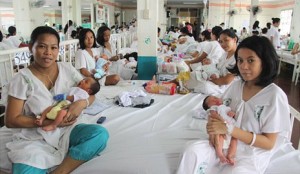The Philippines: Balancing Culture & Contraceptives
Jan 10th, 2012 | By admin | Category: Family PlanningBy Suzanne York, HowMany.org, January 10, 2012
In a country that has one of the highest birthrates in South East Asia, a proposal to provide citizens free contraception sounds like a smart move. But in the Philippines, smart bumps up against culture and religion.
With a population of over 95 million and a total fertility rate of 3.2, the Philippine government has sponsored a reproductive health bill that makes contraception and family planning information free to those who want it.
Last month the BBC ran a story on the debate over the bill. While opposition is mainly coming from the Catholic Church, others opposed to providing free family planning tools include politicians, media commentators, and businessmen. The Church and its allies have blocked similar government proposals in the past. This time, though, President Benigno Aquino is one of the bill’s main backers.
Currently Filipinos can buy contraceptives over-the-counter, but it is cost-prohibitive for many in a country where 56 percent of households live under the international poverty line.
According to the United Nations Population Fund, in 2008, an estimated 3.4 million Filipino women became pregnant, 54 per cent of them are unintended, meaning they occur too soon, too close together or after a couple already has as many children as they want.
The Guttmacher Institute reports that 3 in 10 Filipino women at risk for unintended pregnancy don’t use contraception and that these women account for almost 7 in 10 unintended pregnancies. And it is the poorest women bearing the greatest number of unplanned births. Alarmingly, 10 women in the Philippines die every day while giving birth.
Guttmacher’s research shows that women are having an average of one more child than they actually want. Which makes the government proposal a means to meet the needs of families.
And what about the effect of this on the environment? The Philippines is considered one of the world’s biologically richest countries and is also one of the most threatened. Population growth is a factor. This is what the World Bank has to say:
“Rapid conversion of forestlands and grasslands to urban use is depleting these natural systems. Agricultural yields in lowland areas are stagnating, and population pressures are stimulating cultivation of fragile upland areas, causing serious soil erosion. While estimates of deforestation differ, forest cover in the Philippines has certainly been significantly reduced over the last forty years, due to increasing urbanization, illegal logging, and forest fires.”
Providing family planning is one way to protect the environment, and is one of the easier and more inexpensive ways of doing so.
Culture and religion should be taken into account when promoting family planning, but there needs to be an awareness of the issues impacting women and the state of the national environment. Filipinos should look to Brazil, a predominantly Catholic country, that used a mix of female empowerment and media to lower its fertility rate.
The population of the Philippines is expected to double in the next 30 years. It is in the country’s best interest to see that women and men are provided family planning tools in order to make the right decisions for themselves and their families.
The government bill was proposed in August 2010 and it is still uncertain when a vote will actually vote take place. Stay tuned.
Suzanne York is a writer with the Institute for Population Studies/HowMany.org

